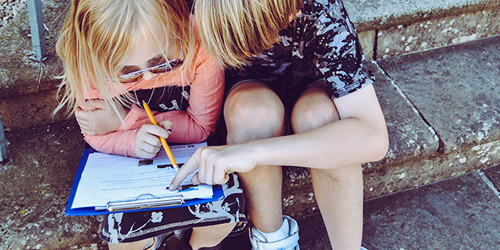Digitalisation has also affected the publishing companies and textbooks. An increasing amount of learning materials is published in digital forms and schools are gradually changing printed books to e-versions. The content is still what matters, not the book itself, declares Mari Kyyhkynen from Otava Learning.
The Content Must Suit the Student’s Level of Development
As the base of education in Finland, the national core curriculum guides also the publishing of textbooks and other learning materials. However, the state does not dictate the material to be used. The aim of all materials shared with the students is to improve their learning and understanding. A good textbook has clear structure and the students find it interesting. The levels of development in each grade are taken into account when material is designed. Children must be able to understand the content, and the quantity must be suitable for their age.
Visuality of the learning material plays a bigger role than expected. “Visuality is a significant part of the product. Besides being appealing, a right kind of visuality supports learning”, says Kyyhkynen. Colours, pictures and graphics matter. An interesting material is much more motivating than a dull one. To fit the visual trends of each era, the publishers in Otava observe the visuality in other media as well. In addition, visual solutions affect the structure of the material and how the students view it. From a good material it’s easy for the students to find the right information also when doing homework or revising for an exam.
Diverse Use of Printed and Digital Material Improves the Students’ Skills Broadly
In the time of digital communication, it’s crucial to teach the children to be critical thinkers. As anyone can write anything online, with the ability to contemplate the source and motives behind the text, a person can form a more realistic picture of the world. Most of the young people have grown up with social media. Because of this, some adults have been worried about the children’s ability to read. But Kyyhkynen sees that the children understand the concept of text in a boarder sense and thus, can read and interpret a range of different sources.
In some situations, the use of printed material is more suitable. This could be because platforms have their own limitations and not all operations can be transferred to digital forms, or simply because the use of pen and paper might just feel more practical. The extent of using digital learning methods depends, among others, from the infrastructure of the school and the students’ access to personal devices. For instance, e-books require use of digital device also at home. Overall, the use of varying learning materials trains the students’ competences in a larger scale.
In Otava, the methods of blended learning are acknowledged already in the planning phase. A range of different products is published to enable the use of both printed and digital materials. The publishing of digital materials takes into consideration the devices available in schools at that moment. With e-books the students can do exercises and have the correct answers show immediately. However, these are balanced with the exercises that are discussed together with a teacher.
Learning Materials Are Only One Part of the Learning Experience
Although textbooks, e-books and other learning materials are an important support for children and teachers, they are only a small part of the whole learning process. Kyyhkynen sees that the broader message from Finland is that: “Learning can’t happen if basics aren’t covered.” The well-being of children should be first priority; from the fundamental needs such as nutrition, exercise and sleep, to having access to health services and student support.
The well-being of children can be acknowledged also in the designing of learning materials. To improve students’ transversal learning and welfare, the materials used shouldn’t focus only in the subject at hand. Also, the quantity of content in the materials shouldn’t be overwhelming for the students. “It is more important that the basics are learnt well, and only after that, new things can be built on top”, remarks Kyyhkynen.
The publishing of new learning material in Finland is a long process. A multi-professional group of experts is involved from the beginning to guarantee the best quality and learning impact. Textbooks and supplementary materials aren’t seen only as something that students use but as a support system for teachers. In fact, for each subject there are guides and materials made specially for teachers.
Otava Learning is official partner Of Polar Partners.
Written by Polar Partners’ Marketing intern Juliaana Kärkkäinen
